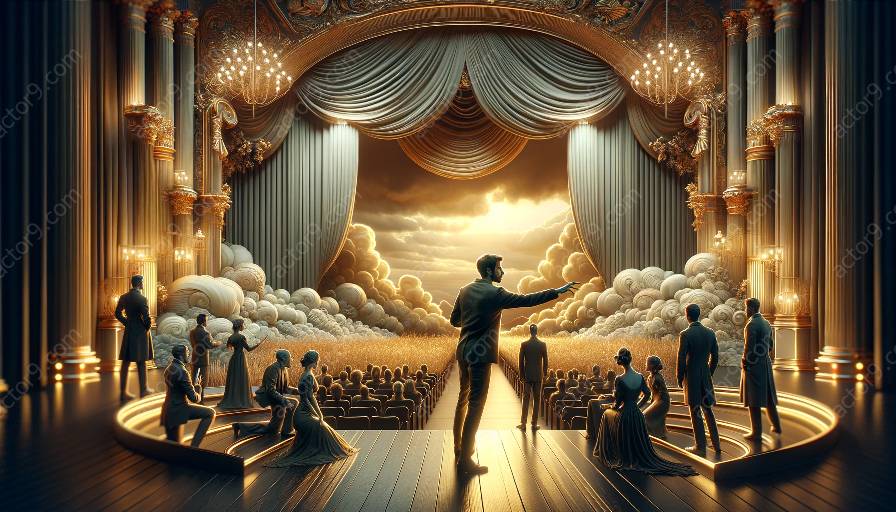Stage directions play a crucial role in shaping the dynamics and aesthetics of a theatrical performance. They provide invaluable guidance to actors, directors, and production teams, helping them bring a script to life in a cohesive and impactful manner. However, the interpretation and execution of stage directions can vary significantly depending on the chosen performance style, be it classical, avant-garde, or experimental theater. Understanding the nuances of adapting stage directions to suit different performance styles is essential for creating compelling and authentic theatrical experiences.
Understanding Stage Directions
Before delving into the adaptation of stage directions for various performance styles, it's important to establish a fundamental understanding of what stage directions entail. In the context of theater, stage directions refer to the instructions provided in the script to guide actors' movements, gestures, blocking, and positioning on stage. They also encompass cues for lighting, sound effects, and set changes, offering a comprehensive blueprint for the entire production.
Stage directions are typically written by the playwright and serve as a roadmap for realizing the intended dramatic vision. While their primary purpose is to ensure consistency and coherence in performances, their interpretation and implementation require careful consideration of the overarching performance style.
Classical Theater
Classical theater, characterized by its adherence to established conventions and textual fidelity, demands a disciplined approach to stage directions. In this traditional style, the faithful execution of stage directions is paramount, as they often hold symbolic or thematic significance. The careful choreography of movements, as dictated by the stage directions, contributes to the grandeur and precision associated with classical productions.
Moreover, in classical theater, stage directions inform the actors' understanding of their characters' physicality and spatial relationships, guiding them in portraying nuanced emotions and interactions. The harmonious alignment between the text and stage directions is crucial in preserving the integrity of classic works and honoring the playwright's intentions.
Avant-Garde Theater
Conversely, avant-garde theater challenges traditional norms and embraces unconventional approaches to storytelling and performance. The adaptation of stage directions in avant-garde theater involves an element of reinterpretation and deconstruction. While the basic structural guidelines provided by the stage directions are acknowledged, avant-garde productions often diverge from literal adherence, encouraging actors and directors to imbue the performance with imaginative and thought-provoking interpretations.
Stage directions in avant-garde theater may serve as points of departure rather than strict dictations, allowing for improvisation and the exploration of unorthodox staging techniques. This adaptability grants artists the freedom to subvert expectations and infuse their own creativity into the realization of the script, fostering innovation and non-conformity.
Experimental Theater
Experimental theater pushes the boundaries of conventional theatrical practices, presenting an ideal platform for radical experimentation and risk-taking. In this domain, stage directions are often approached as suggestive rather than prescriptive, sparking collaborative dialogue between the ensemble, director, and designers. The adaptation of stage directions in experimental theater prioritizes the cultivation of immersive and immersive and unconventional audience experiences, prompting creators to devise inventive methods of incorporating the directions into the fabric of the performance.
Furthermore, experimental theater encourages the organic evolution of stage directions during the rehearsal process, granting leeway for organic discoveries and the emergence of unexpected theatrically potent moments. It thrives on the synergy between text, movement, and design, harnessing the malleability of stage directions to sculpt bold and thought-provoking narratives.
Interplay with Acting
The adaptation of stage directions is intricately intertwined with the art of acting, as it significantly influences performers' portrayal of characters and their interactions within the theatrical space. Actors must navigate the unique demands of each performance style, leveraging their understanding of stage directions to embody the essence of the script and convey the intended emotions and subtext.
In classical theater, actors rely on precise adherence to stage directions to evoke the refined elegance and formalism characteristic of the genre. Their movements and gestures are meticulously choreographed to align with the prescribed stage directions, encapsulating the essence of the era and thematic underpinnings of the play.
Conversely, in avant-garde and experimental theater, actors navigate a more fluid relationship with stage directions, integrating elements of spontaneity and interpretive freedom into their performances. They embrace the opportunity to infuse their characters with unconventional movements and explore unorthodox spatial dynamics, breathing life into the script with a sense of unpredictability and raw authenticity.
In Conclusion
Adapting stage directions for different performance styles is a dynamic process that catalyzes the creative evolution of theatrical storytelling. Whether honoring the traditions of classical theater, defying conventions in avant-garde productions, or charting new territories in experimental performances, the strategic manipulation of stage directions is pivotal in enriching the theatrical landscape.
By nurturing an acute awareness of each performance style's distinct demands and artistic ethos, practitioners in the realm of acting and theater can harness the potential of stage directions to craft immersive, emotionally resonant, and visually captivating experiences for audiences, fostering a deeper appreciation for the art of storytelling on stage.















































